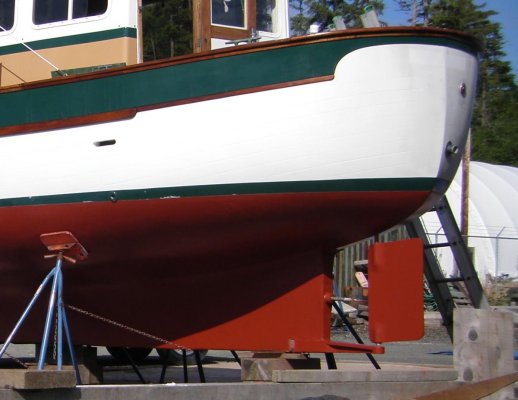dhiggins,
Sounds like you have a semi disp hull if it's like a GB. The formula for HS is 1.34 X the square root of the water line length. Two feet of rake on the stem and the WLL will be 2' less than the overall length.
Semi disp hulls are much less sensitive to hull speed hydrodynamics and tend to respond more like boats called planing hulls. But some semi disp hulls like many DeFevers are quite close to FD hulls and their performance resembles FD hulls more closely. Your boat is probably a tad more like a planing hull than the DeFevers but still may be fairly close to a FD hull.
What this means to you is you can pay less attention to "hull speed" as your boat is more flexible. Like Mark says ... he runs a knot slower than HS. Actually that's the only reasonable option he has. Running HS on a FD hull is making a big wake and as Mark says burning TWICE as much fuel. Sure he can but most all knowledgable FD skippers will run one knot below HS.
Semi Displacement hulls can, rather gracefully, run one knot OVER hull speed as well as exactly at hull speed. They are designed to do so. The GBs are an excellent example. A 36 GB w 250hp will run 8 or 9 knots all the time. That's the glory of the SD hull. It goes faster and does it gracefully. Actually I'm quite sure a FD hull will burn more fuel at hull speed that a SD. Burning considerably more fuel and going more than HS is so desirable (since fuel is cheap) most all trawlers are SD as I think your's is.
It sounds like you've got a GB or a boat like a GB w a single engine. If you want (looks like it) to go over 7 knots there are lots of twin engined boat owners that are fixated on low fuel consumption that will probably trade for your more economical boat. Or do a good job of selling yours and buy a twin that will probably be cheaper. Most trawler owners and shoppers think single engined boats are better. You can use this to your advantage.
Edit:
Just read your OP. We need to know what kind of hull you have but if it's like a old GB yes you can put a bigger engine and go 8 knots or even 9 or 10 if you are willing to pay the fuel burn. If you have an Island Gypsy it may go faster than a GB. What have you got?






